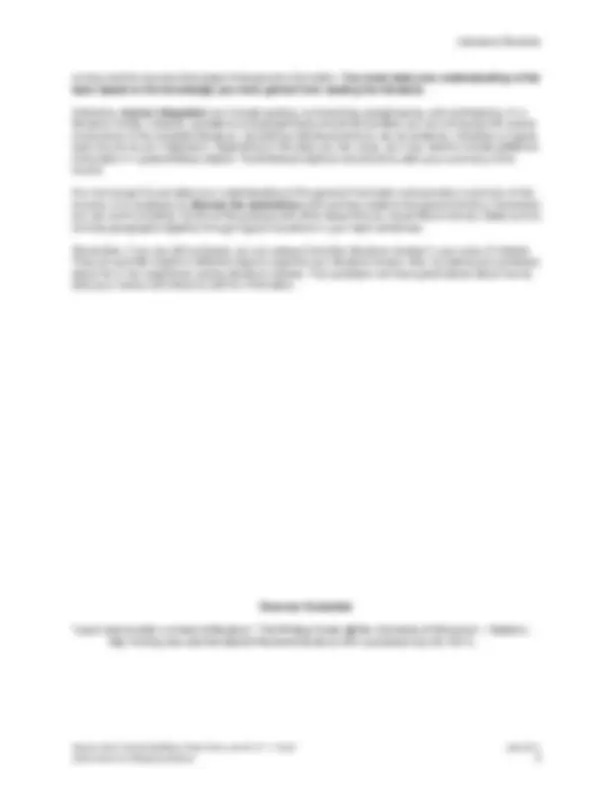



Study with the several resources on Docsity

Earn points by helping other students or get them with a premium plan


Prepare for your exams
Study with the several resources on Docsity

Earn points to download
Earn points by helping other students or get them with a premium plan
Community
Ask the community for help and clear up your study doubts
Discover the best universities in your country according to Docsity users
Free resources
Download our free guides on studying techniques, anxiety management strategies, and thesis advice from Docsity tutors
An introduction to literature reviews, explaining their purpose, structure, and writing techniques. It covers the importance of a literature review in establishing credibility, identifying research gaps, and providing background information. The document also discusses organizing sources and integrating them into the review.
What you will learn
Typology: Schemes and Mind Maps
1 / 3

This page cannot be seen from the preview
Don't miss anything!


Amber Huett, David MacMillan, Katie Crum, and Dr. R. T. Koch July 2011
The idea of “literature” usually conjures up images of dusty books that you are required to read for English, American, or World literature classes. The “literature” in a literature review , however, refers to all the previous research and scholarship on a particular topic, no matter what discipline you are studying; the “review” is your explanation of what the literature says.
A literature review is the synthesis of the available literature regarding your research topic. This synthesis merges the conclusions of many different sources to explain the overall understanding of the topic, thus laying a foundation for both the research question and primary research. Although a literature review will cite sources and should discuss the credibility of the sources included, it is more than an annotated bibliography. Your literature review needs to review all the significant sources on a topic, regardless of whether or not they support the claims you will eventually be working toward.
Your literature review, like any other document, should contain an introduction , a body , and a conclusion.
Introduction
Your introduction should clearly explain the overall research topic and the depth of the information to be presented; it often also explains the types of sources that will be used. If your literature review is part of a larger research proposal or project, its introduction can be combined with the introduction of your paper.
Body
The body of your literature review is intended to give your audience an overview of the already-available research on your topic. This can serve several purposes, including:
Establishing your credibility as an informed researcher Illustrating the importance of a particular problem in a field Identifying a gap in the knowledge of a particular subject Defining key terms and ideas that are used in a particular field Explaining research methods commonly used in a discipline Identifying potential problems with possible research methods Directing the reader toward the research question
Unlike the body of an essay or research paper, the body of a literature review is not intended to directly support a thesis, unless this approach is specifically assigned. Instead, it provides the reader with the background information needed before moving into further study or research. Generally speaking, the overall purpose of a literature review is to establish a framework for further discussion. Present each piece of literature using a claim , evidence , and discussion , but explain general information rather than arguing specifically in support of your thesis.
A literature review should not simply list the relevant sources; that is the purpose of an annotated bibliography. Coherent structure is important. The general information needs to work toward some overall framework. Outlining the sources that you will present can help to provide a structure that will direct your audience toward the research topic.
Literature Reviews
Amber Huett, David MacMillan, Katie Crum, and Dr. R. T. Koch July 2011
Conclusion
Depending on the purpose(s) of your literature review, your conclusion may include the following:
Introduction to further research : The conclusion of your literature review can be used to explain your intended research question. Summary of theories : Your conclusion can summarize central theories and ideas that give your reader a better understanding of the topic. Discussion of the gap : If your literature review has revealed a gap in general understanding, your conclusion can explain the significance of that gap.
Regardless of what your literature review includes, it will always explain what you learned and how this affects your understanding of the various problems or questions within the field. A conclusion should not spend time reiterating the sources already discussed; most of it should focus on presenting the general consensus gleaned from the sources provided.
Organizing the sources in the body of a Literature Review
Organizing a literature review requires you to order your sources according to a progression of ideas and content. Usually, good organization will follow one or more of the patterns of the Modes of Thought , the ways of writing and organizing your paper:
Comparison and Contrast Cause and Effect Problem and Solution Process Description
Illustration Classification Division Narrative
Do any of your sources discuss causes or effects? Do they reveal problems in a field or list solutions? Do they provide illustrations of the topic? Do they define complex theories or ideas? Depending on the way you choose to organize your review, you may end up using different sources multiple times.
It can often be useful to create an outline that contains the plan for organizing your sources before you begin writing. Most strategies for outlining essays or research papers will work just as well for literature reviews.
Review what each of your sources say about the issues that the literature review is exploring. Present them in a way that relates to the overall purpose of your literature review. Ask yourself some of these questions to help review and organize your sources:
Which sources provide general, background, or historical information? Do your sources explain the gaps in your literature, or is that your conclusion? How well do the sources agree on evidence, claims, and methodology? Which sources directly influence your research question? Do you agree with the established understanding in the field, or do you plan to propose a new understanding?
You will need to include all of the available sources that deal with your topic, including sources that present an opposing viewpoint. It is often helpful to place the most relevant and agreeable sources close to the end; this will lead you reader to your point more easily. Grouping similar sources together can keep the audience from becoming confused.
Source Integration
Literature reviews should make distinctions between the pieces of general information you are trying to